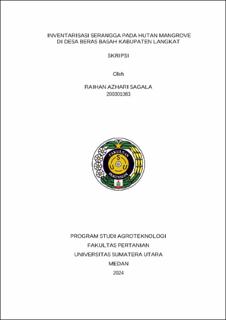Inventarisasi Serangga pada Hutan Mangrove di Desa Beras Basah Kabupaten Langkat
Insect Inventory in Mangrove Forests in Beras Basah Village Langkat Regency

Date
2024Author
Sagala, Raihan Azhari
Advisor(s)
Siregar, Ameilia Zuliyanti
Metadata
Show full item recordAbstract
Mangrove forests are a type of forest that grows around coastal areas that are inundated at high tide and free of inundation at low tide. Mangrove forests have a role in fauna life including as a source of food and shelter for various living things, one of which is insects. This study aims to determine the types of insects and their populations in the Mangrove Forest in Beras Basah Village, Langkat Regency. Insect identification in the Laboratory of Plant Pests and Diseases, Faculty of Agriculture, University of North Sumatra carried out from January to February 2024. This study uses the absolute method (by direct observation) and the relative method. In direct observation, insects were captured using a swip net. In the relative method used traps (yellow sticky trap and blue pan trap) around the mangrove forest area. The total number of insects identified in the mangrove area was 9 orders 35 families, 42 genera, and 1525 individuals. The total value of KM and FM in the use of Swip Net traps total KM = 345 FM = 54, and the use of Yellow Stikcy Trap total KM = 750 FM = 52, and the use of Blue Pan Trap traps total KM = 430 FM = 35. The calculation of the species richness index value of each trap is R = 5.84, 6.62 and 6.06. The evenness index of each species E = 0.93, 0.85 and 0.79. And the Diversity Index value of each trap is as follows. The number of insects identified in the mangrove area was 33 families, 42 genus, and 1518 individuals. The highest population is the order Diptera as many as 473 individuals and the lowest population is the order Mantodea with a total of 15 individuals. The mangrove area has an insect diversity index value H' = 3.24, species richness index margalef R = 7.33, species evenness index E = 0.87. The total insect population of scavenger/decomposer insects were 7 species, herbivorous insects were 12 species, pollinator insects were 2 species, predator insects were 16 species, parasitoid insects were 1 species and disease vectors were 4 species.
Collections
- Undergraduate Theses [3369]
